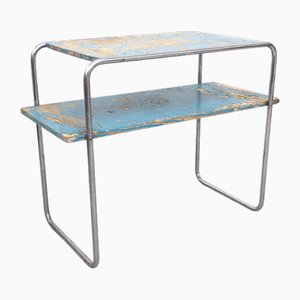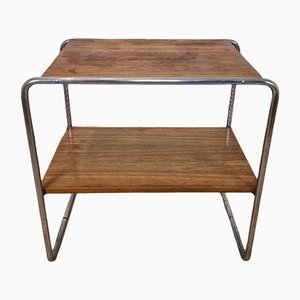
Born and raised in Pecs, Hungary, famed modernist architect-designer Marcel Breuer earned a scholarship to study painting and sculpture at Vienna Academy of Fine Art in 1920, but quickly dropped out and applied to the Bauhaus school in Weimar, Germany. After completing his preliminary courses there, he trained at the Bauhaus furniture workshop between 1921 and 1924. He then went on to run the furniture workshop at the new Bauhuas in Dessau, where he created what is cited as the first tubular steel armchair (1925-1926), presented in 1927 as the Type B3 Steel Club Chair (and later renamed the Wassily after Bauhaus teacher Wassily Kandinsky).
After a brief spell in Switzerland Breuer joined former Bauhaus director Walter Gropius in London in 1935. As Breuer’s career progressed, he began to focus more on architectural projects than design. In addition to his tubular steel furniture and plywood pieces for the Isokon company, he was recognized for residences, shop interiors, and multiple competition entries.
In 1937, Breuer and Gropius moved to the US, both teaching for a time at Harvard and briefly partnering in an architectural practice. Together, they designed the Pennsylvania Pavilion for the 1939 New York World’s Fair in addition to multiple private dwellings. Their partnership dissolved in 1941, but the two remained friends. In 1946, Breuer left Harvard and opened an office in New York. Over the course of the rest of his career, Breuer designed over seventy private houses and multiple university and office buildings. Notably, in 1948, the Museum of Modern Art in New York organized a touring exhibition of his work, and the following year, commissioned him to design a house in its garden; both events significantly boosted Breuer's career. In 1953, he designed UNESCO’s headquarters in Paris with Pier Luigi Nervi and Bernard Zehrfulss, and, in 1963, he designed the Whitney Museum of American Art in New York.
Breuer died in New York in 1981.



